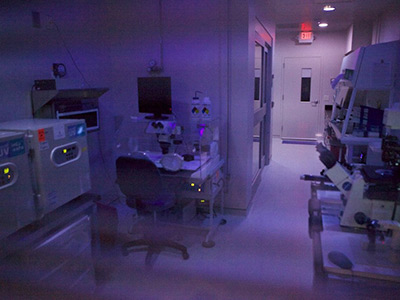
Embryology Laboratory
Our embryology lab was designed from the collective research, knowledge, and experience our team of experts has gleaned over the last 25+ years. The space is isolated from the outside world with tight seals, and the environment is pressurized, which allows strict control of temperature, humidity, and air purity.
The in vitro fertilization journey begins in a procedure room adjacent to the IVF lab. There, eggs (oocytes) are removed from the patient’s ovaries with a thin ultrasound-guided needle while she is sedated. On the same day, our embryologist processes oocytes and exposes eggs to sperm in one of two ways: ICSI or conventional insemination.
Conventional Insemination & Intracytoplasmic Sperm Injection
For conventional Insemination, Embryologists place a processed sperm sample in each droplet with small groups of eggs, allowing the sperm to fertilize the eggs overnight.
During Intracytoplasmic sperm injection (ICSI), Embryologists inject one viable sperm into each mature egg. ICSI is indicated for all male factor cases.

What happens between ICSI & Biospy
Embryo Biospy for PGT
At Atlantic Reproductive, all embryos are cultured to the blastocyst stage of development. Preimplantation genetic testing (PGT) is an umbrella term that covers preimplantation genetic diagnosis and chromosome and genetic screening. Preimplantation genetic testing is carried out on an embryo conceived by IVF before the embryo is transferred to the uterus. PGT examines a few cells removed from the part of the embryo that will develop into the pre-placenta (the trophectoderm) and does not touch the inner mass cells that will develop into the baby. Only embryos with a genetic chance of developing into healthy babies will be transferred.
Vitrification is a method of cryopreserving your oocytes or embryo development so they can be stored for future use.
Fertility Preservation
Fertility preservation is a way to protect your ability to have children in the future and involves saving eggs, sperm, or embryos for future use. People choose fertility preservation for many reasons, including medical treatments, age-related decline, and fertility, and personal or lifestyle reasons. Standard options for fertility preservation include egg, sperm, and embryo freezing.

